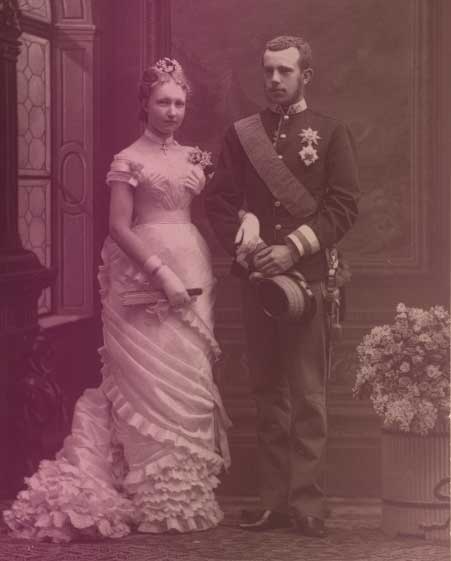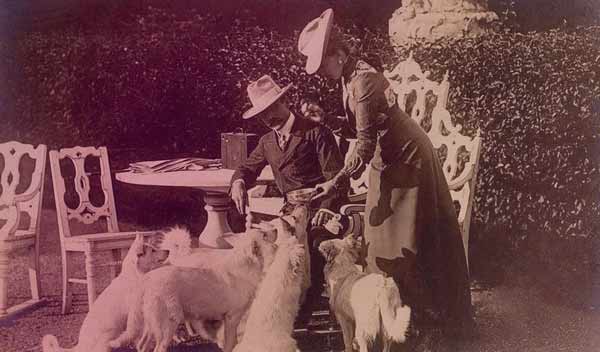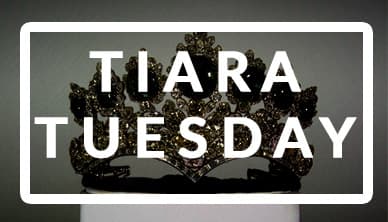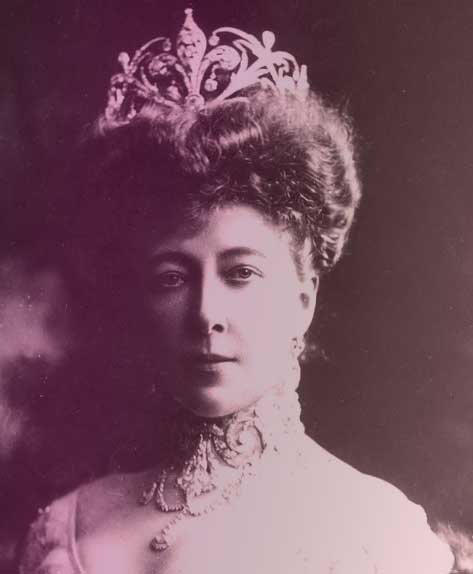Share this Post
Princess Stéphanie of Belgium’s tiara was made by Chaumet. She got it when she married the heir to the Austrian throne in 1881. We have very little information about this tiara, but we have a crap-ton of information about Stéphanie herself, so buckle up – it’s gonna be a bumpy ride.
Poor Stéphanie grew up basically ignored by her shitty parents, King Leopold II and Queen Marie Henriette. Those two could barely stand each other, and Leopold spent most of his time colonizing the Congo, getting filthy rich off its natural resources, and accumulating a collection of mistresses that would have made Casanova need to catch his breath. Her mother eventually retired from court life so she could stop pretending to give a shit.
In 1880, King Leopold invited Crown Prince Rudolf of Austria for a visit. It made sense – Leopold had two remaining daughters to marry off, and there were slim pickings for Catholic royal families in the marriage market of the time.
Unfortunately, a Belgian princess wasn’t Rudolf’s first choice. He fell hard for his quiet and sickly cousin, Archduchess Maria Antonia of Tuscany, but his parents didn’t want a quiet, sickly Empress of Austria, so they told him to keep looking.
Rudolf fell hard for his quiet and sickly cousin, but his parents told him to keep looking.
Conspiracy theory alert #1: Some believe he and Maria Antonia had a secret marriage and a child. Rudolf later said “thanks but no thanks” to a couple of Spanish infantas, at which point, his parents really started to get pissed. So there he was, under the gun, invited to Belgium given his pick of the two unmarried girls, Princess Stéphanie and Princess Clementine.
He decided he liked Stéphanie best.
Fifteen-year-old Stéphanie was packed off to the formal and dreary Austrian court. But when the Austrian ladies-in-waiting realized she hadn’t even hit puberty yet and no one had given her the bird and the bees talk, they threw up their hands and sent her home. The Belgians sent her back a year later at age 16, and she duly married Rudolf.

So It Was Happily Ever After, Right?
Nope. Misery cloaked this marriage like white on rice. While Rudolf and Stéphanie did have a daughter in 1883, things fell apart soon afterward. Stéphanie’s disastrous childhood made her hard to get along with – it seems she was always seeking the affection her parents never gave her, which made her a bit self-absorbed. She was also proud and deeply conservative. Rudolf was…not. He was liberal, manic, melancholic, and probably inherited a touch of the madness that ran in his mother’s family (those damn Wittelsbachs).
Stéphanie’s mother-in-law, Empress Elisabeth, didn’t think she was good enough to be Empress of Austria. Elisabeth called Stéphanie an “ugly bumpkin,” so that relationship was fucked from the get-go. Also, Stéphanie later wrote that Rudolf gave her what was likely gonorrhea, making her infertile, so that relationship went to hell in a handbasket, too.
Here’s how Stéphanie described the whole arranged marriage thing: “Two quite young persons see each other for the first time, know each other a quarter of an hour, and speak the binding word which death alone can untie. If there is something beautiful in the thought that two human beings who love and respect one another are joined before God in holy matrimony, so there is something uncommonly repulsive in the idea that such a union can be formed without any preparation and remain a lie from the altar to the grave.”
“Two quite young persons see each other for the first time, know each other a quarter of an hour, and speak the binding word which death alone can untie. If there is something beautiful in the thought that two human beings who love and respect one another are joined before God in holy matrimony, so there is something uncommonly repulsive in the idea that such a union can be formed without any preparation and remain a lie from the altar to the grave.”
Crown Princess Stéphanie
Ouch.
Mayerling
If that word means anything to you, you know what’s coming next. In late 1888, Rudolf fell in love with a 17-year-old baroness, Marie Vetsera. He’d wanted to divorce Stéphanie for awhile now, but the old emperor wouldn’t hear of it and demanded he give Marie up. Instead, Rudolf proposed a suicide pact. First, he asked a prior mistress, who said no. Then he asked Stéphanie, who said no.
So what does Rudolf do? Proposes the same pact to his new teenage mistress.
Although it’s not ironclad, here’s the generally accepted version of what went down. He took Marie to his hunting lodge, Mayerling, and proposed the murder-suicide pact. Behind a locked door, Rudolf shot Marie in her left temple, point blank, and then shot himself in the head. They had to bandage his head and hands for the family’s private viewing of his body, and reconstruct his skull out of wax so the body could be displayed at the traditional lying-in-state. The news had to be censored so Rudolf could receive a Catholic burial. It was originally reported that he died of “apoplexy” – read the original Reuters telegraph dispatch here.
The incident at Mayerling inspired a bunch of movies, books, and conspiracy theories. There’s a 1968 movie called Mayerling where Omar Sharif plays Rudolf, Catherine Deneuve plays Marie Vetsera, and Ava Gardner plays Empress Elisabeth. There’s also a Japanese manga called Angel’s Coffin about Rudolf and Marie, which you can read online for free – it’s both beautiful and disturbing.
It’s said that Rudolf left a suicide note, although it’s disputed by those who say the note isn’t authentic. In the note, Rudolf left a message for Stéphanie: “You are freed from the torment of my presence; be happy in your fashion. Be good to the poor little one, who is the only thing that remains of me.”
“You are freed from the torment of my presence; be happy in your fashion. Be good to the poor little one, who is the only thing that remains of me.”
Crown Prince Rudolf, in a suicide note of disputed authenticity
Whatever she felt for Rudolf or believed about the note’s authenticity, Stéphanie kept it with her until the day she died. It is now supposedly in the archives of the Hungarian monastery where she passed away. Today, Mayerling is a church. The large cross in the main chapel sits on the exact location of the bed where the two bodies were discovered. It costs almost six bucks to get in. Good times.
Conspiracy theory alert #2: Empress Zita of Austria believed Rudolf and Marie were murdered as part of a political plot to keep the liberal Rudolf off the throne of Austria. Fall into this rabbit hole at your own peril.
Let’s Get Back to Stéphanie, Shall We?
Right. Stéphanie. Here she is, wearing this tiara:
Okay, so the story took a dark turn there – but we’re not done yet. The Austrian court was shocked by Rudolf’s death, which couldn’t be called a suicide so he could be buried on holy ground. They needed to blame someone and Empress Elisabeth chose Stéphanie. Elisabeth said Stéphanie wasn’t emotionally supportive enough, which drove Rudolf to suicide. The accusation made life at court even harder for her, but much like Taylor Swift, she understood that haters gonna hate hate hate hate hate, so she did her best to travel a lot and rebuild her life as she saw fit.
Both Franz Josef and Leopold II wanted Stéphanie to remarry, and they had just the guy in mind – Archduke Franz Ferdinand, the guy whose murder triggered World War I.
But Stéphanie had ideas of her own.
In 1900, she decided to marry a Hungarian count named Elmer Lonyay. She had to give up her titles and her place in the imperial family to do it – and she didn’t hesitate. She even gave guardianship of her daughter to her father-in-law, Emperor Franz Josef.
It seems the old emperor knew how hard marriage to his son had been. Franz Josef paid for her trousseau for this second wedding and let her hold the ceremony at the family’s castle of Miramar in Trieste. He even rode with Stéphanie on the train out of Vienna, although he didn’t go all the way and attend the actual ceremony (protocol is such a bitch). Something about this charms me – I’ve never had much feeling for Franz Josef one way or the other, but this tips me toward liking him.
Franz Josef paid for her trousseau and let her hold her second wedding at the castle of Miramar in Trieste. I’ve never had much feeling for Franz Josef one way or the other, but this tips me toward liking him.
Stéphanie’s actual parents were way more pissed off than her in-laws. Her dad disinherited her, which is rich, considering the atrocities he was committing in the Congo. Stéphanie and her sister Louise (also disinherited for trying to get out of a shitty marriage) tried to sue Leopold in 1902 to get part of their dead mother’s fortune. It didn’t work. After Leopold died in 1909, they sued the Belgian government to try and get part of their father’s millions. That didn’t work, either.
My conclusion? (a) Leopold was a dick, and (b) the girls’ lawyers sucked.

In 1935, Stéphanie wrote a memoir that was only published outside Austria. She called it I Was to Be Empress, which tells me she was still a teensy bit bitter about the whole Mayerling thing.
Oddly enough, she also became something of an inventor and in 1908 got several European patents for – wait for it – a new style of chafing dish. The New York Times seemed mystified as to why she wouldn’t also get a patent in the U.S., because everyone knows Americans kick ass at using a chafing dish. I’m not making that up; it’s actually what the article says. If you click the link, and I recommend you do, the article beneath that one describes a sea skipper who claims to have been stalked by a sea serpent for two days and saw a floating island populated by pink monkeys. So anytime you feel like today’s journalists have lost their integrity, just remember Princess Stéphanie’s chafing dish and a floating island of pink monkeys.
Anytime you feel like today’s journalists have lost their integrity, just remember Princess Stéphanie’s chafing dish and a floating island of pink monkeys.
Stéphanie lived in Hungary for the rest of her life, fleeing her husband’s castle only as the Red Army marched through in 1945. She died in a Hungarian abbey a couple months after the war ended.
What Happened to This Tiara?
I don’t know. Shit. I hate having to write that. Stéphanie and her daughter were estranged. The daughter inherited Rudolf’s behavioral issues, which meant they didn’t get along at all. Stéphanie left all her money and possessions to the abbey in which she died. Because World War II had just ended and Hungary was on its way to becoming a Soviet satellite state, the history here gets lost and garbled. We need to put this tiara on a milk carton, in other words.
How I’d Wear It
I’ve been working on this post for hours now, and the hubby keeps asking me, “Are you done yet?” No, I’m not done. This is serious shit and it takes time. I can’t answer all the questions swirling around this tiara in a few measly hours. What really happened at Mayerling? And where the hell is this tiara? Were I independently wealthy, I’d find the answers for you guys.
But I’m not. All I have is my imagination.
So if I had Princess Stéphanie of Belgium’s tiara, I’d wear it when I need to interrogate people and get some answers. (Apparently, I’m also now a private investigator or a cop who needs to interrogate people.) I’d sit my suspect down on a folding chair in a dark room, with a flashlight in my hand. I’d shine the light in his or her eyes, and then I’d shine it on the sparkling diamonds in this tiara. And then I’d say, “You see this? No one knew where it was until I found it. That’s what I do. I find things. In just a minute, I’m gonna go find Jimmy Hoffa. But first, you’re gonna tell me why one black sock didn’t make it out of the dryer and where all the rest of my missing socks ended up.”
Because, you know, that’s apparently the most pressing issue I have to interrogate someone over.
That’s Princess Stéphanie of Belgium’s Tiara
Want to suggest a tiara? Drop its name or a photo link into the comments. I’ll do my best to find something interesting in its history for a future issue of Tiara Tuesday.
Image credits
Stéphanie: Image by an unknown photographer, public domain via Wikimedia Commons
Stéphanie & Rudolf: Oscar Kramer, public domain via Wikimedia Commons
Stéphanie & Lonyay: Image by an unknown photographer, public domain via Wikimedia Commons

Love Royalty and Tiaras?
You might like my other site, The Girl in the Tiara. I created it to write about amazing royal women and their tiaras. It’s like Drunk History meets The Crown.

Tiara Tuesday Archives
Visit the archives to read about more royal shenanigans. And by shenanigans, I mean war, revolution, betrayal, lust, murder, diamonds, and Princess Stéphanie’s chafing dish.
Share this Post


Comments
I love this so freaking much.
Hi Beth! Thanks so much for commenting. I love Stephanie’s story, too…despite all the gloom and doom, I like to think of her as a late bloomer who finally was able to stand up for herself and find love. 🙂
Hello!
I love your article of Stephanie. Why was Sissi so bad of this poor woman? And for me Stephanie is not ugly, i have see photo of her when she was young, I think she was pretty.
By the way, do you will make an article on the empress Frederick ( Vicky the daughter of the queen victoria)?
Thanks so much for your comment! I think Stephanie was pretty, too – and I hate how hard Sissi was on her. I think poor Stephanie got a raw deal. Anyone who had the courage to step away from court life to make a second marriage for love is A-okay in my book. I would love to write about Empress Frederick one of these days! She’s one of my favorites. I just need to track down a tiara of hers as a starting point. In the meantime, I did write a few short thoughts on Goodreads when I read Hannah Pakula’s excellent biography of Vicky. You can see it here: https://www.goodreads.com/book/show/252193.An_Uncommon_Woman_The_Empress_Frederick
So glad to meet someone else who has a soft spot for Stephanie!
Jenni 🙂